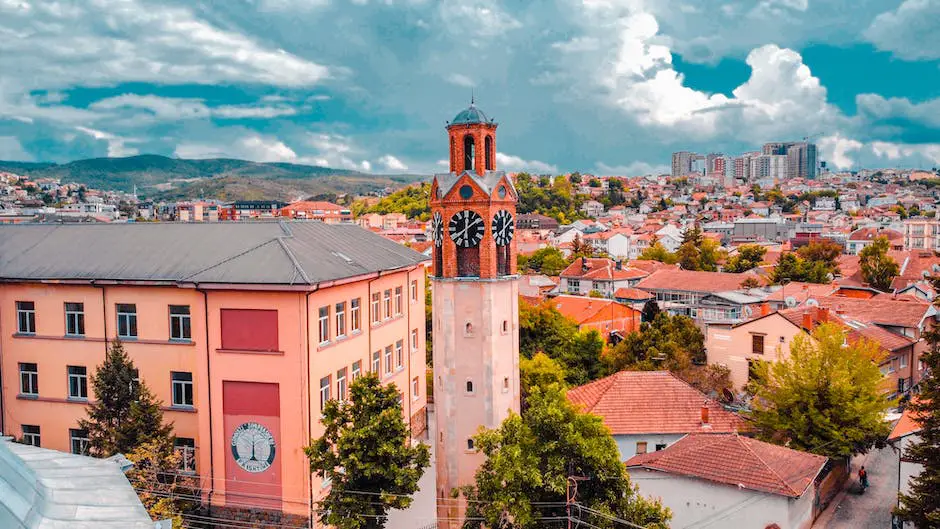
Pristina’s architecture tells a story, a narrative woven through the ages, reflecting its rich history and the ever-changing socio-political landscape. As I meander through the city’s streets, I can’t help but marvel at the eclectic mix of styles, from Ottoman influences to brutalist Yugoslav buildings, and now, the contemporary designs that are reshaping the city’s skyline. It’s a tapestry of design that captures the imagination and speaks volumes about Kosovo’s capital.
The Ottoman Legacy
Strolling through the Old Town, the Ottoman influence is unmistakable. The mosques and hamams, with their intricate tile work and domed roofs, stand as a testament to centuries of history. The Imperial Mosque, for instance, is a cornerstone of Pristina’s architectural heritage. Built in the 15th century, it’s a relic of a bygone era, yet it remains a vibrant part of the community. It’s fascinating how these structures have withstood the test of time, isn’t it?
Yugoslav Modernism and Brutalism
Fast forward to the 20th century, and you’ll find a stark contrast in the city’s architectural landscape. The Yugoslav period brought about a wave of modernism and brutalism, characterized by concrete, geometric shapes, and a sense of imposing strength. The National Library of Kosovo is a prime example, often sparking debate among locals and visitors alike. Some say it’s an eyesore, while others argue it’s an iconic piece of architectural art. Love it or hate it, it certainly makes a statement.
The Contemporary Shift
In recent years, Pristina has been undergoing a transformation. New buildings with glass facades and sleek lines are popping up, signaling a move towards contemporary architecture. The city is embracing change, and it’s evident in projects like the Mother Teresa Square. This modern public space reflects a forward-thinking Pristina, one that respects its past but looks eagerly to the future.
Preservation and Progress
Amidst this evolution, there’s a delicate balance between preserving the old and embracing the new. It’s a dance of sorts, where each step is carefully considered. The restoration of traditional houses in the historic district shows a commitment to conservation, while the construction of the new business district showcases the city’s ambition. It’s a city that’s not afraid to dream big, but also one that holds its history close to its heart.
Challenges and Opportunities
Of course, with rapid development come challenges. Urban planning and sustainable growth are hot topics in Pristina. The city faces the task of integrating new structures without disrupting the urban fabric. It’s a puzzle, but one that offers immense opportunities for architects and city planners to innovate and create a harmonious blend of old and new.
FAQs
What is the most iconic example of Ottoman architecture in Pristina?
The Imperial Mosque, also known as the Xhamia e Mbretit, is a standout example of Ottoman architecture in Pristina. Its historical significance and continued use make it a living piece of the city’s heritage.
How has Yugoslav architecture influenced Pristina?
Yugoslav architecture introduced brutalism to Pristina, which can be seen in buildings like the National Library of Kosovo. This style has given the city a unique character and has become an integral part of its architectural identity.
What are some contemporary architectural projects in Pristina?
Contemporary projects include the Mother Teresa Square and the emerging business district. These developments reflect Pristina’s modern aspirations and its desire to become a regional hub for business and culture.
Conclusion
Pristina’s architecture is a reflection of its storied past and its dynamic present. From the Ottoman-era mosques to the brutalist structures of the Yugoslav period, and now the sleek contemporary designs, the city’s skyline is a mosaic of influences. As Pristina continues to grow and evolve, it does so with a deep respect for its history and an eye towards sustainable and innovative development. It’s a city that’s not just building buildings; it’s building a future while honoring its past. And that’s something truly special.
In conclusion, Pristina’s architecture is a fascinating blend of history and modernity. The city’s ability to preserve its heritage while embracing new design trends is a testament to its resilience and vision. For anyone interested in architecture, Pristina offers a unique case study in balancing tradition with progress. As the cityscape continues to evolve, it will undoubtedly remain a source of inspiration and intrigue for years to come.